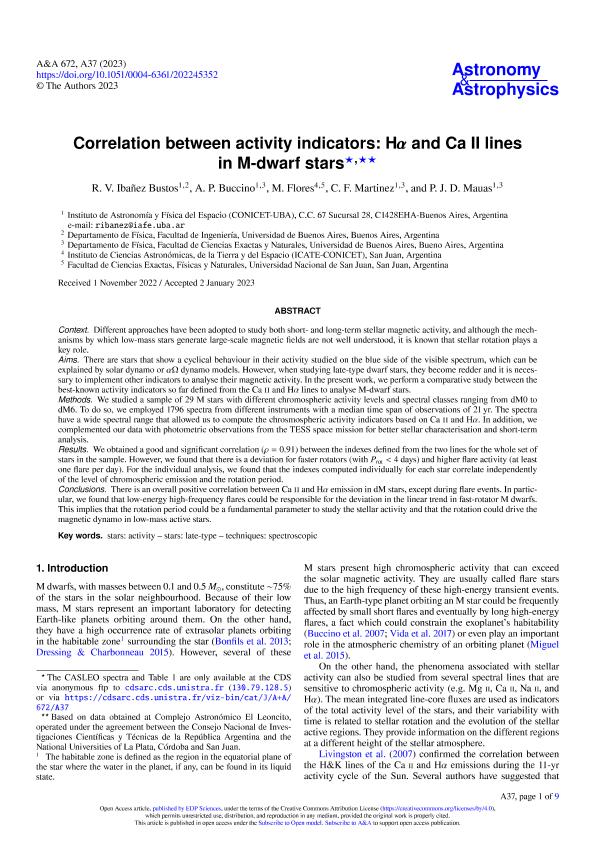Artículo
Correlation between activity indicators: Halpha and Ca II lines in M-dwarf stars
Ibañez Bustos, Romina Valeria ; Buccino, Andrea Paola
; Buccino, Andrea Paola ; Flores, Matías; Martínez, Cintia Fernanda
; Flores, Matías; Martínez, Cintia Fernanda ; Mauas, Pablo Jacobo David
; Mauas, Pablo Jacobo David
 ; Buccino, Andrea Paola
; Buccino, Andrea Paola ; Flores, Matías; Martínez, Cintia Fernanda
; Flores, Matías; Martínez, Cintia Fernanda ; Mauas, Pablo Jacobo David
; Mauas, Pablo Jacobo David
Fecha de publicación:
01/2023
Editorial:
EDP Sciences
Revista:
Astronomy and Astrophysics
ISSN:
0004-6361
Idioma:
Inglés
Tipo de recurso:
Artículo publicado
Clasificación temática:
Resumen
Context. Different approaches have been adopted to study both short- and long-term stellar magnetic activity, and although the mechanisms by which low-mass stars generate large-scale magnetic fields are not well understood, it is known that stellar rotation plays a key role. Aims. There are stars that show a cyclical behaviour in their activity studied on the blue side of the visible spectrum, which can be explained by solar dynamo or αΩ dynamo models. However, when studying late-type dwarf stars, they become redder and it is necessary to implement other indicators to analyse their magnetic activity. In the present work, we perform a comparative study between the best-known activity indicators so far defined from the Ca II and Hα lines to analyse M-dwarf stars. Methods. We studied a sample of 29 M stars with different chromospheric activity levels and spectral classes ranging from dM0 to dM6. To do so, we employed 1796 spectra from different instruments with a median time span of observations of 21 yr. The spectra have a wide spectral range that allowed us to compute the chrosmospheric activity indicators based on Ca II and Hα. In addition, we complemented our data with photometric observations from the TESS space mission for better stellar characterisation and short-term analysis. Results. We obtained a good and significant correlation (ρ = 0.91) between the indexes defined from the two lines for the whole set of stars in the sample. However, we found that there is a deviation for faster rotators (with Prot < 4 days) and higher flare activity (at least one flare per day). For the individual analysis, we found that the indexes computed individually for each star correlate independently of the level of chromospheric emission and the rotation period. Conclusions. There is an overall positive correlation between Ca II and Hα emission in dM stars, except during flare events. In particular, we found that low-energy high-frequency flares could be responsible for the deviation in the linear trend in fast-rotator M dwarfs. This implies that the rotation period could be a fundamental parameter to study the stellar activity and that the rotation could drive the magnetic dynamo in low-mass active stars.
Palabras clave:
STARS: ACTIVITY
,
STARS: LATE-TYPE
,
TECHNIQUES: SPECTROSCOPIC
Archivos asociados
Licencia
Identificadores
Colecciones
Articulos(IAFE)
Articulos de INST.DE ASTRONOMIA Y FISICA DEL ESPACIO(I)
Articulos de INST.DE ASTRONOMIA Y FISICA DEL ESPACIO(I)
Articulos(ICATE)
Articulos de INST.D/CS ASTRONOMICAS D/LA TIERRA Y DEL ESPACIO
Articulos de INST.D/CS ASTRONOMICAS D/LA TIERRA Y DEL ESPACIO
Citación
Ibañez Bustos, Romina Valeria; Buccino, Andrea Paola; Flores, Matías; Martínez, Cintia Fernanda; Mauas, Pablo Jacobo David; Correlation between activity indicators: Halpha and Ca II lines in M-dwarf stars; EDP Sciences; Astronomy and Astrophysics; 672; 1-2023; 1-9
Compartir
Altmétricas



